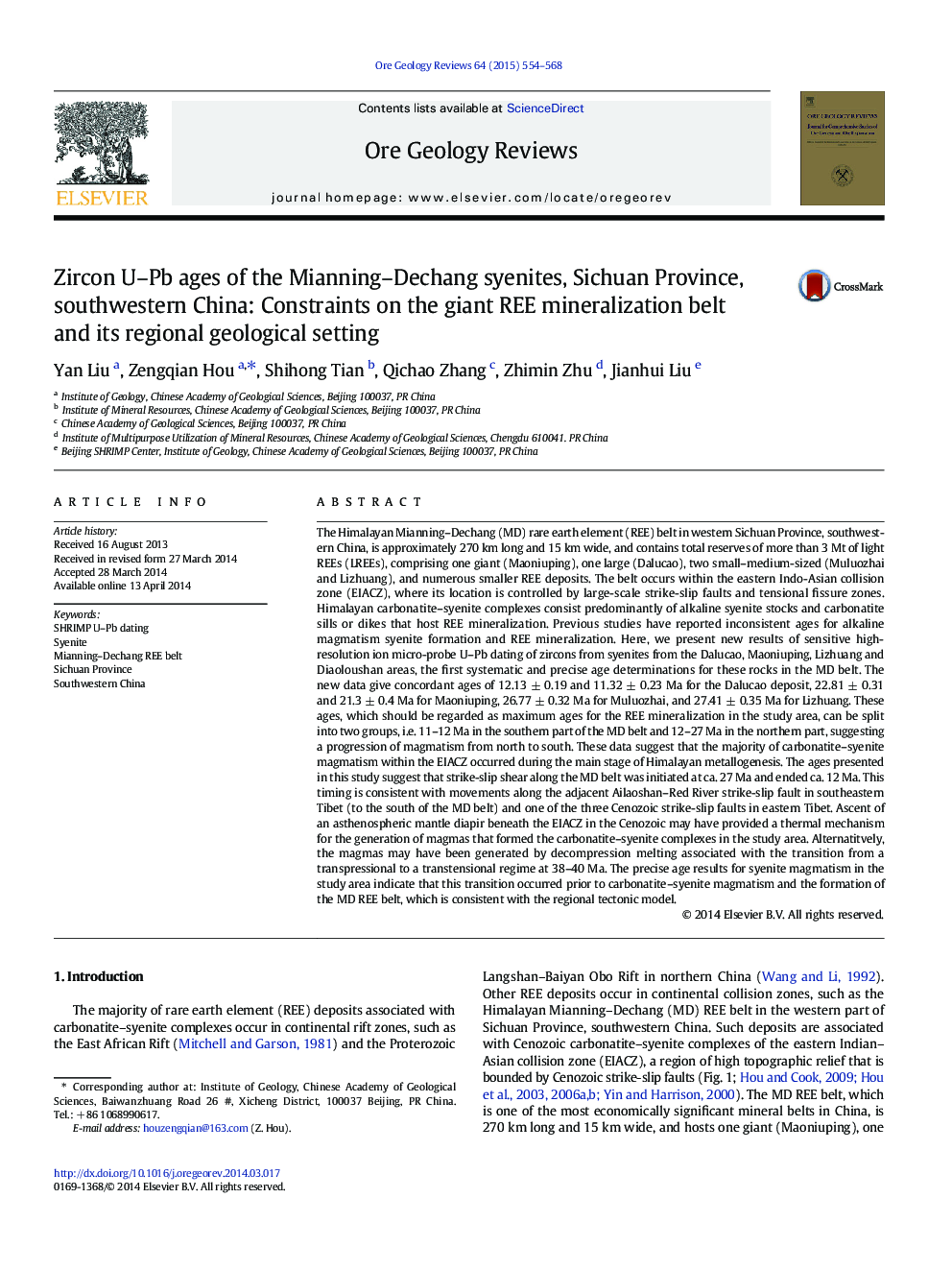| کد مقاله | کد نشریه | سال انتشار | مقاله انگلیسی | نسخه تمام متن |
|---|---|---|---|---|
| 4697124 | 1637239 | 2015 | 15 صفحه PDF | دانلود رایگان |

• Syenites were formed at 12–27 Ma in Sichuan Province, SW China.
• 27–12 Ma are maximum ages for the giant REE mineralization belt in the eastern Tibet.
• Strike-slip fault along the REE belt started from 27 Ma and ended at 12 Ma or now.
• Syenite were formed after regional tectonic transition (38–40 Ma).
The Himalayan Mianning–Dechang (MD) rare earth element (REE) belt in western Sichuan Province, southwestern China, is approximately 270 km long and 15 km wide, and contains total reserves of more than 3 Mt of light REEs (LREEs), comprising one giant (Maoniuping), one large (Dalucao), two small–medium-sized (Muluozhai and Lizhuang), and numerous smaller REE deposits. The belt occurs within the eastern Indo-Asian collision zone (EIACZ), where its location is controlled by large-scale strike-slip faults and tensional fissure zones. Himalayan carbonatite–syenite complexes consist predominantly of alkaline syenite stocks and carbonatite sills or dikes that host REE mineralization. Previous studies have reported inconsistent ages for alkaline magmatism syenite formation and REE mineralization. Here, we present new results of sensitive high-resolution ion micro-probe U–Pb dating of zircons from syenites from the Dalucao, Maoniuping, Lizhuang and Diaoloushan areas, the first systematic and precise age determinations for these rocks in the MD belt. The new data give concordant ages of 12.13 ± 0.19 and 11.32 ± 0.23 Ma for the Dalucao deposit, 22.81 ± 0.31 and 21.3 ± 0.4 Ma for Maoniuping, 26.77 ± 0.32 Ma for Muluozhai, and 27.41 ± 0.35 Ma for Lizhuang. These ages, which should be regarded as maximum ages for the REE mineralization in the study area, can be split into two groups, i.e. 11–12 Ma in the southern part of the MD belt and 12–27 Ma in the northern part, suggesting a progression of magmatism from north to south. These data suggest that the majority of carbonatite–syenite magmatism within the EIACZ occurred during the main stage of Himalayan metallogenesis. The ages presented in this study suggest that strike-slip shear along the MD belt was initiated at ca. 27 Ma and ended ca. 12 Ma. This timing is consistent with movements along the adjacent Ailaoshan–Red River strike-slip fault in southeastern Tibet (to the south of the MD belt) and one of the three Cenozoic strike-slip faults in eastern Tibet. Ascent of an asthenospheric mantle diapir beneath the EIACZ in the Cenozoic may have provided a thermal mechanism for the generation of magmas that formed the carbonatite–syenite complexes in the study area. Alternatitvely, the magmas may have been generated by decompression melting associated with the transition from a transpressional to a transtensional regime at 38–40 Ma. The precise age results for syenite magmatism in the study area indicate that this transition occurred prior to carbonatite–syenite magmatism and the formation of the MD REE belt, which is consistent with the regional tectonic model.
Journal: Ore Geology Reviews - Volume 64, January 2015, Pages 554–568